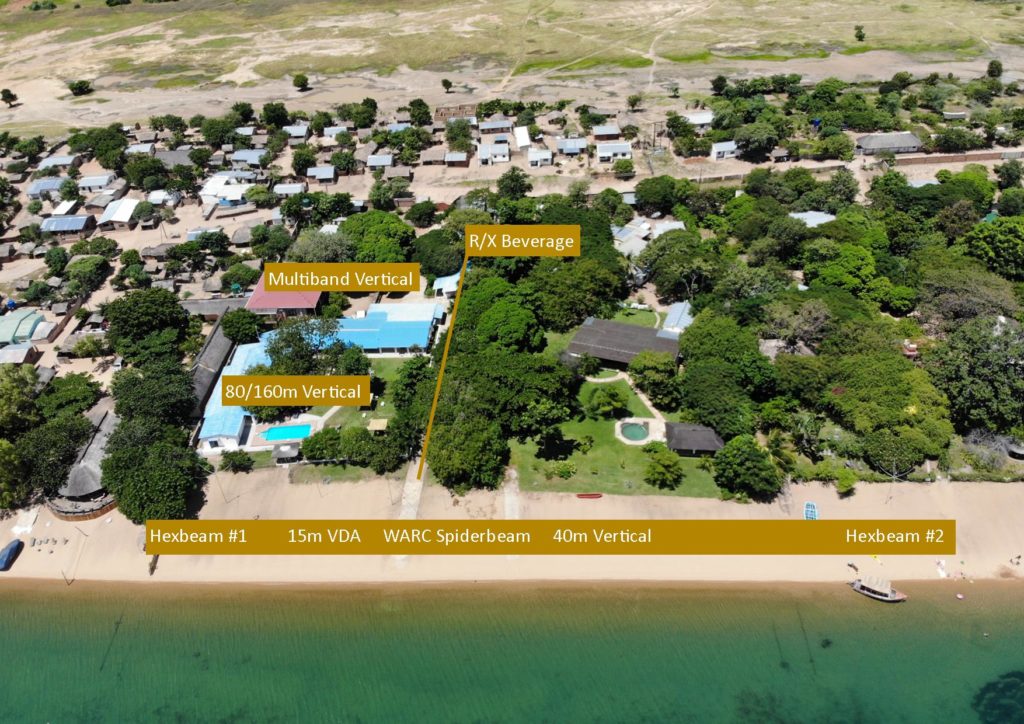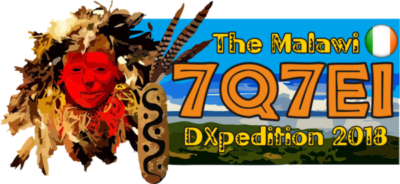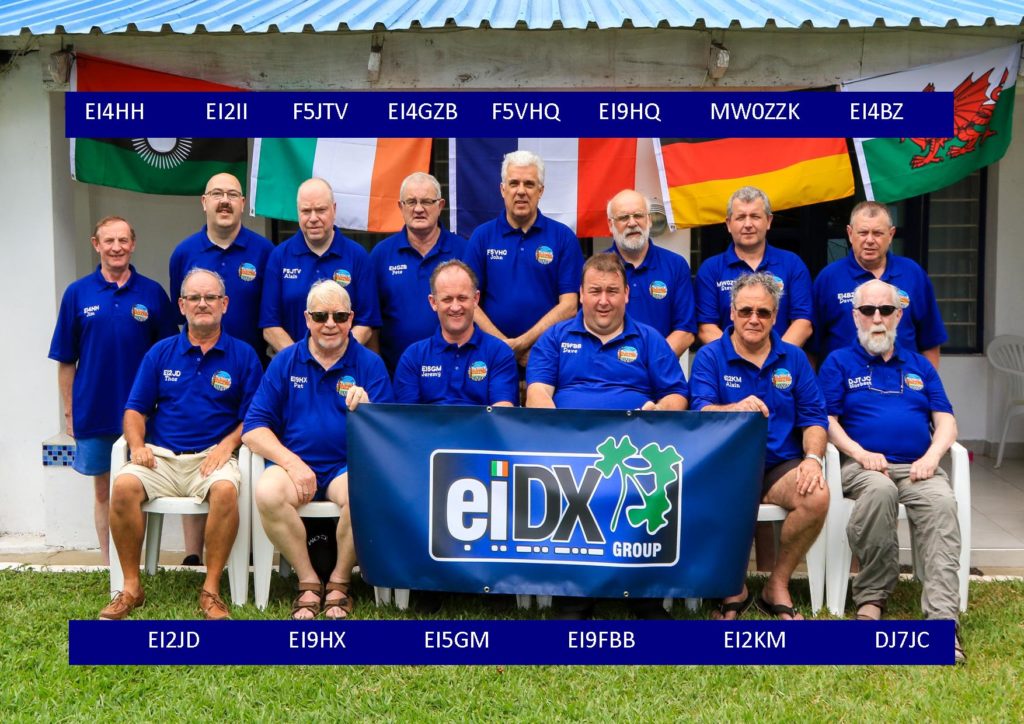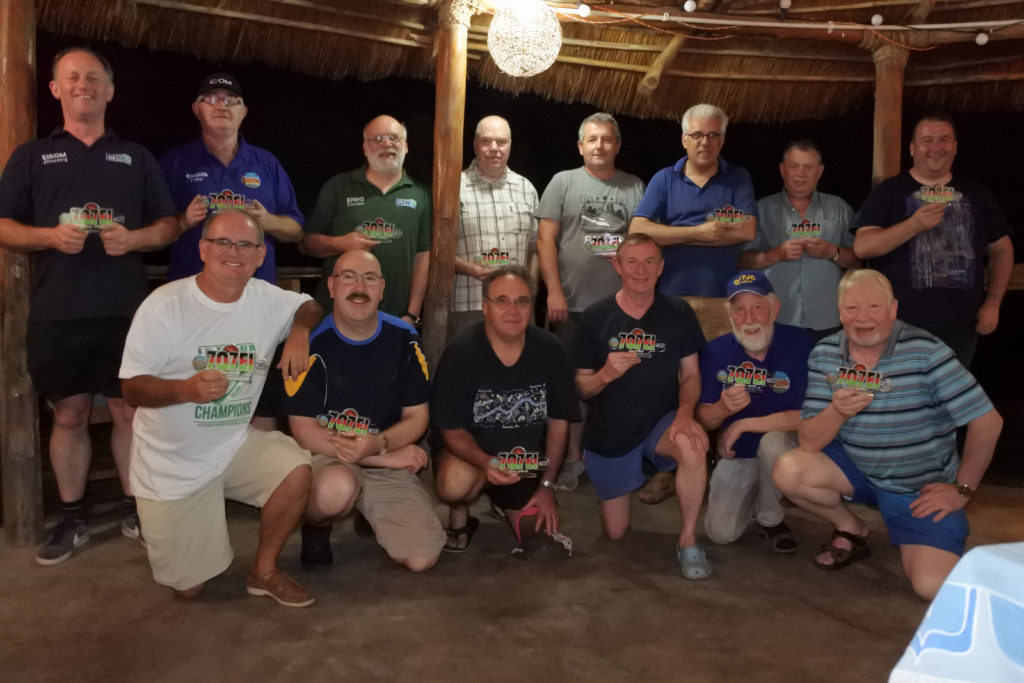7Q7EI Malawi 2018
The EIDX Group was formed in January 2016, and consisted originally of Irish Amateurs. Since then we have expanded, and today our membership consisting of Irish, English, French, & German DXers.
The group is growing and open to anyone who is interested in working DX, or maybe looking to travel with a DXpedition team to sought after countries.
Our first Dxpedition to 9N7EI Nepal in March 2017, was a major success where we logged in excess of 30,000 QSO’s.
Shortly after returning from Nepal, our minds were turned to choosing our next DXpedition, as all of the Nepal group were anxious and ready to go again in 2018.
Choosing a new DX country is not as straight forward as one might think, the group had to keep in mind and consider the following.
- It had to be affordable.
- Possible to get an operating License.
- It would need to be well positioned in the most wanted, Club Log Rankings
- Have stable 220-volt Electricity, & with Generator back up.
- Comfortable accommodation, and with a nice warm climate.
- Easy fly in and out to the destination.
- Have ample room to erect multiple antennas.
- Most importantly – somewhere relatively safe!
After a couple of months of searching and deliberation, the group leaders fixed their sights on Malawi 7Q, as it ticked all of the above boxes.
So in October 2017, the DXpedition country for 2018 was formally tabled at a meeting in Portlaoise where a slide show in Power Point was presented to all, showing the location, Hotel selected, Cost, and all the other necessary details, required for a person to consider signing up to take part.
A little introduction to Malawi 7Q.
Malawi is located on the East side of Africa, south of the equator, and is one of the smallest countries, Area 118,484 km2, of which 20% is taken up with Lake Malawi, Ireland (Area 84,421 km2)
Population 18.09 million (Ireland 4.773 million)
GDP $22 Billion in 2017 (Ireland $294 Billion)
Malawi got its independence from the United Kingdom on the 6th of July 1964, so it’s easy to see that the English left its print firmly on the country, with right hand drive cars and buses, road signage is all in English, and so on it goes.
The Common language is English, but they also have seven local languages, with “Chichewa” being the national.
The Team
A 14 man team was soon compiled and consisted of the following EIDXG members:
DJ7JC, EI2II, EI2JD, EI2KM/F8FUA, EI4BZ, EI4GZB, EI4HH, EI5GM, EI9FBB, EI9HQ, EI9HX, F5JTV, F5VHQ & MW0ZZK.
Each team member brought something to the team and between us all, a huge variation of skills were abundant. Many were seasoned DXpeditioners and had vast experience in operating intense pile-ups while others were just being introduced into the fascinating world of DXpeditioning. An equal balance of SSB, CW and Digital operators were present too with many having experience in the latest FT8 mode. We were the first DXpedition team to successfully use FT8 in ‘Fox and Hound’ mode and our presence/findings was instrumental to the development in this unique ground breaking mode.
Our journey to Malawi began on the 22nd of March 2018, with all meeting at Dublin Airport Terminal 1, where over 500kg’s of luggage and equipment was collected, weighed, tagged, with 2 pieces of luggage allocated to each person for checking in and carrying to Malawi.
The first leg of our flight was 9-hours which took us to Addis Ababa Bole, Ethiopia International Airport, a 4-hour stop over, and then a further 4-hour flight to Lilongwe Airport Malawi.
After a tedious and nerve wrecking experience, with Malawi customs and emigration control, we now began a game of Tetris shuffling both men and bags around the bus till we were fully loaded and could sit back and enjoy the beautiful 5 hour trip to Annie’s Lodge, Cape McClear, during the first few hours we had day light and some amazing views of the country and a real look at the living conditions change as we went further from the capital. So too did the road as by the time it was dark one would think it was a road in Connemara we were on with potholes the size of a bath tub. By 19:30 we had reached our destination.
Cape McClear is a small town on the southern shore of Lake Malawi, and is part of the National Park. In fact, our location was indeed situated right in the midst of a UNESCO world heritage site! In 1859 the missionary and explorer David Livingstone found the Cape, and named “Cape McClear” after his friend, the astronomer Thomas McClear, who was Her Majesty’s astronomer at the Cape of Good Hope.
WPX SSB Contest
As part of the DXpedition, we had planned to take part in the WPX SSB Contest, but arriving at our Hotel on the 23rd at 19:00 with the WPX contest starting at 00:00 on the 24th left us little time to prepare, we did not have the daylight we thought we would have had. But after a quick late supper, the team got busy setting up the stations and antennas.
Construction by torch light was the only option but determination prevailed and by midnight we had a Hex Beam in the air and ready to call CQ WPX _._

The following morning at 1st light, the installation of the remaining antennas went into full swing, prioritising what was needed to keep the contest station operating and making best use of the space we had available. When finished we had two Hex Beams 20-10m, a WARC Spider Beam for 30,17 & 12m, a Vertical for 80 & 160m, VDA 15m, Vertical 40 & 10m and a Beverage for the Low Bands. The Cape McClear location was fantastic for antenna installation, as all the beams were located on the beach of Lake Malawi, the only antenna not in the sand was the 80 / 160m vertical.
Our operating station design
Learning from our past experience meant we couldn’t trust conditions to be predictable and each operating point would have to be ready to adopt whatever mode was open at the time. In planning for this we decided to split the shack into zones with designated stations by band so as to reduce the amount of antenna and filter swapping, each station had to be setup to run all modes and changeover needed to be simple.
At the core of our operating points was the Icom IC-7300, a simple Lightweight rig with all the elements we needed, especially the single interface cable giving rig control, keyer and soundcard functionality. The ability to restore predefined configs made change over between SSB/CW and FT8 a simple task. To help with our band presence we used the Acom 1010 amp again, this was sticking with our weight budget and operating simplicity in mind. This year we invested in some High Power filters, learning from our past experience these proved invaluable.
Each operating point had a windows7 laptop running on a wireless network with one master point for central log and cluster access. This master laptop also maintained a time sync for the FT8, something we did have difficulty with as our internet access was sporadic and some (time) drift crept in when we were off line for a few days.
To reduce the number of steps required when changing modes the following plan was hatched, our choice for DXpedition SSB/CW was to use Wintest. As a familiar platform for all the operators using it all week would be most efficient option. To reduce changeover time and avoid log contamination we ran N1MM+ for the CQ-WPX contest. N1MM+ was also used throughout the DXpedition for all the digital modes with an easy RTTY interface and central log facility for FT8 stations included. Other utilities such as Hamcap were also used on each station for band predictions. All of the logs were up loaded and sent to our QSL manager Charles M0OXO periodically where an internet connection allowed for inclusion in Club Log.
The 5 operating points were all colour coded, stating which antenna connected, and what bands covered, the colour code on the operating station, matched the operating schedule colour, prepared and posted on the walls adjacent to the operating positions, see samples below.
Station No 1 Red Station 160m, 80m Vertical & Hex Beam 1, 20-10m.
Station No 2 Blue Station Hex Beam 2, 20-10m & 80m Dipole.
Station No 3 Green Station Spider Beam 12, 17, & 30m.
Station No 4 Orange Station Multi Band Vertical, 10 & 12m
Station No 5 Yellow Station Vertical 40m & 15m VDA.
Azimuth Map for our location in Malawi was used, & generated courtesy of Tom NS6T.

Some Challenges
Setting up and operating a DXpedition station from a third world country comes with its own challenges and our biggest one was of course a stable electrical supply.
Malawi generates only 80% of the electricity required to run the country, so on a daily and nightly basis, without warning there are power cuts throughout the country, our experience was as many as 12 to 14 times daily, these cuts could last for 5 minutes to 5 hours, so it was nearly impossible to get a good run at building numbers. As soon as the power was restored, all the systems would have to be reset & synchronised, Internet connection restarted, Laptop USB ports re-established, amplifiers warming up all took time while we watched the delightful comments on the cluster suspecting we had gone QRT for the day. The Hotel did have a generator but that was only for extreme emergencies and our request’s to run the generator on a permanent basis dismissed due to the high cost.
After days trying, we did source in a near town, a portable Generator with great expectations, but when connected it only gave us 180-volts and not sufficient to run the equipment.
As mentioned above, the frequent power outages, also caused major problems to the Internet providers, we only had a connection when it suited them.
The weather forecasters in Malawi are very accurate, with predictions a month or so in advance, but into our second week, with all 5 stations running flat out, and plenty of QSO’s being logged, out of the blue, and without any warning, a mini Tornado came in across the lake, and took down two of the Antennas, and threw the large WARC Spider Beam up into the trees nearby, breaking three of the fibre glass spreaders and getting completely tangled. It took until the following evening (24 hours later), before the spreaders were repaired with Epoxy resin, and the beams back up again.
The food supplied by the Hotel was of good quality and with good choices, three meals per day, breakfast at 08:00, lunch at 14:00 and dinner at 20:00, the lunches & dinners were ordered a day in advance, as to give the hotel time to source our selections, but unfortunately some of our op’s got the dreaded stomach bugs, with one of our guys being sick and in bed for 3-days.
On all DXpeditions, there are two sides, the unfortunate I have already outlined but on the good side, which without doubt over weighed the bad items, are the following.
Our location was top class, the hotel property had a beach front to the Lake, with a fantastic take off all round over the water, from 300deg to 120deg.
When we had electricity our equipment worked flawlessly, and a pleasure to operate.
The pile up’s were fantastic when propagation was favourable, which let the operators live their dream and experience real pile up’s.
With good propagation and good runs going, it was joy to watch the master logging station, clocking up the qso’s collected from the 5 operating stations.
Taking part in the WPX SSB contest was a bonus.
Support from fellow Echo India’s was great and a staggering 86 unique EI callsigns made it into the log totalling almost 400 QSOs!
The weather was very good, with the temperature daily in the 30’s, we had a swimming pool in the garden, and if you wanted you could have a swim in the lake.
The Hotel was fantastic, all the rooms were spotless, and serviced on a daily basis, all the rooms were equipped with a fridge, tea making facility’s, air conditioning, and the hottest water that ever came out of a shower.
The hotel staff were extremely friendly, and went out of their way to help us.
With a local audience of kids on the beach all day every trip to turn the beam was an adventure, they had carvings to sell or a song to sing if it would relieve you of a few dollars. Even to our amusement the odd “Céad Míle Fáilte” was heard once they found out we were Irish.

What we took back from the trip.
With the best planning in the world, you cannot control the day to day situations that may occur, like the loss of electricity, internet, bad propagation, poor quality of operators calling without listening, storms brewing without any notice, sickness tummy bugs etc, so it’s best just to get on and concentrate with what can be controlled.
To conclude, the above is a short description and summary of events which took place on our DXpedition to Malawi, and we all thoroughly enjoyed the trip, and cannot wait for the next one.
The EIDX Group would like to thank all our sponsors and to those who supported us on this our 2nd DXpedition as a group.
Sincere thanks to the IRTS for their generosity and support. It’s great to have the support of our National Society behind us!
We made over 37,000 QSO’s see below the break down
| Band | CW | FT8 | SSB | RTTY | Total | Total % |
| 160 | 7 | 230 | 0 | 0 | 237 | 0.6% |
| 80 | 330 | 317 | 0 | 0 | 647 | 1.7% |
| 40 | 1525 | 619 | 743 | 378 | 3265 | 8.8% |
| 30 | 2180 | 272 | 0 | 125 | 2577 | 6.9% |
| 20 | 4683 | 412 | 2723 | 341 | 8159 | 22.0% |
| 17 | 2148 | 165 | 5616 | 259 | 8188 | 22.1% |
| 15 | 2922 | 217 | 4220 | 364 | 7723 | 20.8% |
| 12 | 1968 | 11 | 1362 | 251 | 3592 | 9.7% |
| 10 | 1187 | 13 | 1362 | 130 | 2692 | 7.3% |
| Totals | 16950 | 2256 | 16026 | 1848 | 37080 |
We worked 154 DXCC’s see breakdown below.
DXCC by Band/Mode breakdown
| Band | CW | FT8 | SSB | RTTY | Total |
| 160 | 4 | 36 | 0 | 0 | 37 |
| 80 | 42 | 41 | 0 | 0 | 50 |
| 40 | 68 | 52 | 56 | 49 | 85 |
| 30 | 77 | 27 | 0 | 24 | 79 |
| 20 | 89 | 49 | 94 | 26 | 111 |
| 17 | 79 | 27 | 116 | 24 | 122 |
| 15 | 92 | 28 | 106 | 36 | 117 |
| 12 | 74 | 0 | 72 | 7 | 87 |
| 10 | 63 | 2 | 61 | 19 | 76 |
| Totals | 117 | 65 | 138 | 67 | 154 |
Breakdown by Continent
| Continent | Total QSOs | % |
| Africa | 410 | 1.1 |
| Asia | 2840 | 7.7 |
| Europe | 29180 | 78.7 |
| North America | 4213 | 11.4 |
| Oceania | 106 | 0.3 |
| South America | 331 | 0.9 |
| Totals | 37080 | 100.0 |
We entered a score of over 3 million points in the CQ WPX SSB contest and just as going to print, we received our #1 in Malawi certificate! In fact, not only were we also #1 in Africa, but we even set a new African record!
Well what’s next for the EIDX Group?
‘DX Féile’ weekend on Inishmore, Aran Islands has become a firm favourite both Nationally and Internationally with delegates visiting this year from Norway, USA, Scotland, Wales, Finland, England, France, Germany and of course all 4 corners of Echo India. The uniqueness of this DX Convention and its location on EU-006 is a major attraction. See dxfeile for more information.
Our Irish Islands IOTA Tour has seen huge interest amongst IOTA chasers worldwide and to date we’ve netted well over 20,000 QSOs. A project like this has never been done before in EI and to activate all IOTA groups in one season has received great publicity. We will have 3 stations QRV during DX Féile which will see the last activation being EU-006. More on this to follow in a forthcoming issue of Echo Ireland.
Promoting the Group and Amateur Radio as a whole to encouraging DX activity throughout Ireland.
Have a presence at most EI rallies and events.
Planning continues for our next DXpedition in 2019 and will be announced shortly ———– 5v7ei.
73’s
By Enda Broderick EI2II & Pat O’ Connor EI9HX



